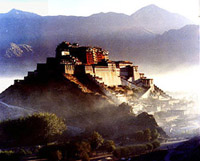
The Potala Palace, a tourist destination in the capital of southwest China's Tibet Autonomous Region, is enjoying a quieter busy season thanks to a restriction on the number of its visitors.
According to an official from the Potala Palace Administration Office, only 850 tourists or pilgrims will be allowed for visiting every day. During the opening 4 hours in morning, 50 visitors are restricted to enter in every 20 minutes. During the 2.5 hours in afternoon, it is in every 30 minutes that the Place allows 50 visitors.
The official told that the measure was implemented mainly because the architecture are not strong enough to support much weight of many tourists.
The 1,300-year-old red and white palace, the former office compound of Tibetan rulers which has served as the residence of Tibetan religious leaders, the Dalai Lamas, since the 17th century, formerly received an average of 1,500 visitors and pilgrims every day, with the record number of visitors in one day at 5,000.
Cultural relic experts and officials believed such a heavy flow of visitors posed a threat to the ancient palace and cultural relics in it.
With many ancient Tibetan classics, frescos and sculptures in it, the majestic Potala Palace is regarded as the greatest achievement of Tibetans in architecture and art. The palace was listed as a World Cultural Heritage site in 1994.
To better protect the world-famous palace, local tourism and cultural relic authorities decided at the end of May that the palace can receive no more than 850 visitors and pilgrims a day. It is now open six hours a day.
According to Qamba Gaisang, an official in charge of the management of the palace, only 50 visitors are admitted into the palace every 20 minutes for four hours in the morning, while the time span expands to 30 minutes for two hours in the afternoon.
Previously, a visit to the palace would take at least three hours and the structure endured a weight of some 45 tons during the rush hours, with the weight of each visitor calculated as 60 kilograms, Qamba said.
Also, the number of visitors to the palace increases every year by 20 percent.
The 113-meter-tall, 13-floor palace was built with earth, stone and wood. Few nails were used in the construction.
"We were afraid that the heavy flow of visitors to the ancient palace might cause the rafters to break and the ground to crack," Qamba said.
The famous Fawangdong, or the Cavity for the King, is the narrowest place in the palace, where a maximum of 15 people can stand. However, Gao Feng, a tourist guide, said that sometimes scores of visitors, at times even about a hundred, would crowd there before the restriction was made.
"The crowds were not only a threat to the safety of the palace, but would also dampen visitors' moods," Gao said.
"While on the one hand, the restriction can alleviate the tension imposed by swarming visitors on the ancient building, visitors themselves can also benefit from the restriction, as they can enjoy their visits with more leisure," Qamba said.
Qamba said that the restriction will not greatly affect pilgrimage to the palace, as the palace sees few pilgrims during the bustling tourism season when local farmers and herders are occupied by their summer work.
The management has also strengthened measures to prevent fires in the palace. There used to be some 10,000 ghee lamps, which Qamba said were a great danger to the safety of the cultural relics in the palace.
The number has now been reduced by half and a special salvage corps was recently established to prevent fires, and security-checking devices will also soon be installed, Qamba said.
According to Xu Fei, deputy director of the regional cultural relic bureau, the autonomous region boasts some 2,000 cultural relic sites, 27 of which are under state level protection. The central government has invested over 300 million yuan (over 36 million US dollars) in the maintenance and protection of cultural relics in the region since 1951.
Seipei Hubert, a tourist from Germany, said that restricting the number of visitors is a good way of better protecting the palace. "It's good for both the ancient palace and for the visitors." he noted.
Qamba suggested that tourists book tickets at least a day ahead of their visits.
(Xinhua News Agency August 14, 2003)
|

